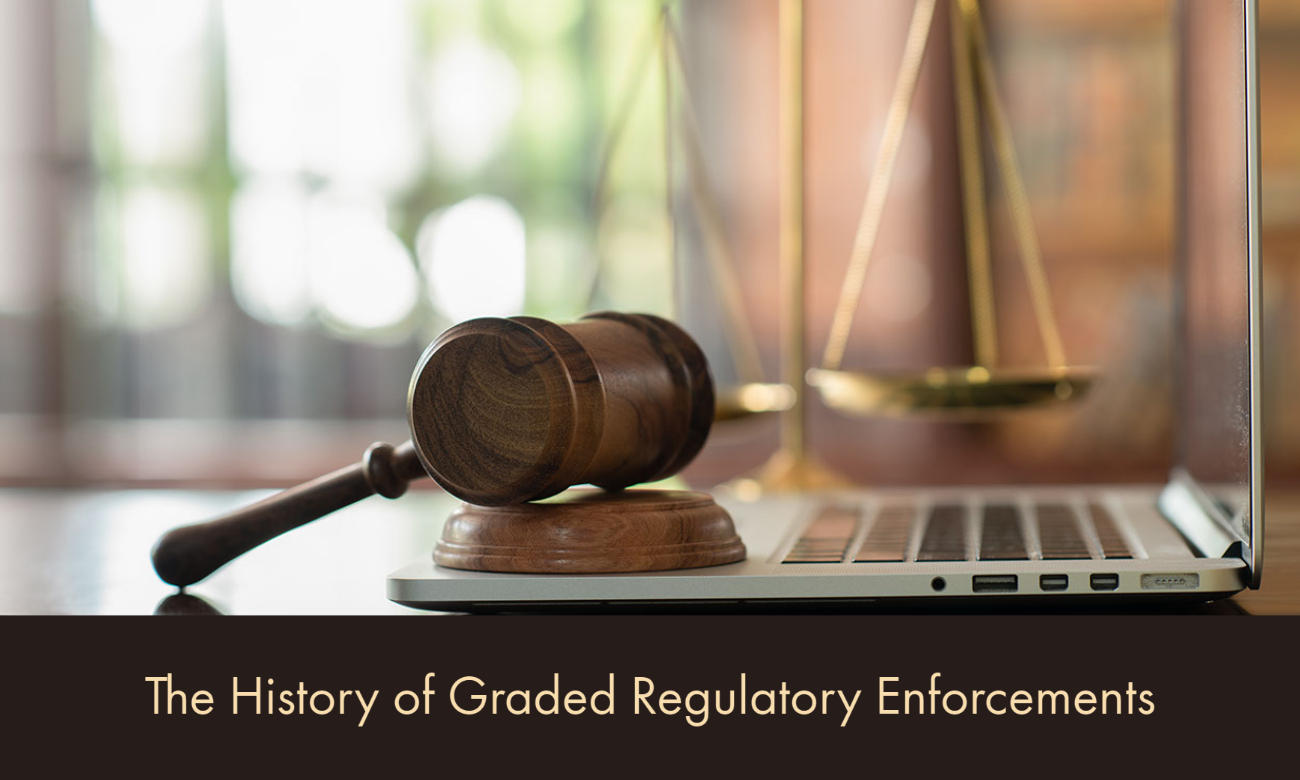The History of Graded Regulatory Enforcements of India: A blog about Indian Graded Regulatory Enforcements and why we need our own published system of enforcements

Laws, Rules, and Regulations are destined to be enforced. An ecosystem that does not allow the permeation of law and effective enforcement thereof thwarts the very purpose of the law. Historically, the seriousness of enforcement in India was severely affected due to various factors, including cultural backdrop, lack or absence of a political will, lack of expediency on the part of the bureaucracy, Grassroot corruption, and connivance enforcement officials. As a result, the law-abiding business community lost faith in the system and became confident of getting away with the violations they committed. But this phenomenon has been gradually changing for the better during the last few years.
Company law stipulated that companies’ responsibility of governance, risk, and compliance rests with the Board of Directors (BOD). Therefore, the BOD collectively and the Directors individually are liable for losses arising out of non-compliance. While a Compliance Officer is responsible for implementing compliance processes and executing such strategies at a micro level, the BOD is responsible for formulating policies, mechanisms, procedures, and internal controls.
None of the regulators, perhaps except SEBI, vehemently and vociferously publish the penal actions against wrongdoers. Such publicity may be a deterrent for the erring entities but has a vast systemic and industry impact. This could be one of the reasons that RBI is more perceived to be a persuasive regulator than a punishment-hungry regulator.
For sustained and effective enforcement of Governance Risk and Compliance protocol, researchers suggest a graded, persuasive mechanism at a base level, monetary penalties at a secondary level, and stringent exemplary, punitive actions at a tertiary level. This will require a careful analysis of all legal and regulatory provisions for trifurcation of their implications into:
Non-compliance that have only implications for data collection.
Violations that have a revenue impact on the state exchequer.
Violations that have systemic risks apart from revenue implications.
Laws, Rules, and Regulations are destined to be enforced. An ecosystem that does not allow the permeation of law and effective enforcement thereof thwarts the very purpose of the law. Historically, the seriousness of enforcement in India was severely affected due to various factors, including cultural backdrop, lack or absence of a political will, lack of expediency on the part of the bureaucracy, Grassroot corruption, and connivance of enforcement officials. As a result, the law-abiding business community lost faith in the system and became confident of getting away with the violations they committed. But this phenomenon has been gradually changing for the better during the last few years.
Company law stipulated that companies’ responsibility of governance, risk, and compliance rests with the Board of Directors (BOD). Therefore, the BOD collectively and the Directors individually are liable for losses arising out of non-compliance. While a Compliance Officer is responsible for implementing compliance processes and executing such processes at a micro level, the BOD is responsible for the formulation of policies, mechanisms, processes, and internal controls.
None of the regulators, perhaps except SEBI, vehemently and vociferously publish the penal actions against wrongdoers. Such publicity may be a deterrent for the erring entities but has a huge systemic and industry impact. This could be one of the reasons that RBI is more perceived to be a persuasive regulator than a punishment-hungry regulator.
For sustained and effective enforcement of Governance Risk and Compliance protocol, researchers suggest a graded, persuasive mechanism at a base level, monetary penalties at a secondary level, and stringent exemplary, punitive actions at a tertiary level. This will require a careful analysis of all legal and regulatory provisions for trifurcation of their implications into:
Non-compliance that have only implications for data collection.
Violations that have a revenue impact on the state exchequer.
Violations that have systemic risks apart from revenue implications.
Restorative Justice (for compliance with data implications): When organizations fail to comply with any provision of law that calls for data or information (E.g., non-filing or filing with wrong data), the Restorative Justice approach should be adopted. The delayed filing or rectification of wrong filing should be allowed. This approach will restore compliance rather than reverting to an instant punishment. Many business regulators have adopted this approach in several jurisdictions across the globe. Many regulators also use this as a tool to respond to compliance failures.
Restorative Justice, of course, must always be backed up by the possibility of more punitive sanctions. This gives regulators the option of responding to recurring non-compliance by corporates with punitive sanctions. It is also imperative to make it known to the corporate world that “softer” enforcement strategies will be followed by harsher measures in case of persistent non-compliance. Simultaneously, voluntary and consistent compliance needs to be complimented and incentivized. For example, a company with a clean track record could be graded on A, B, C categories. The grading could be displayed on the master data or can be publicized through some rating agency. This eventually nurtures the ability of enterprises to accomplish compliance through self-motivation.
Responsive Enforcement (For compliances that have revenue implications to the state): Non-compliances that adversely affect revenue to the state exchequer need to be treated with monetary penalties, including penal interests and fines. The system should automatically capture the delay in remittance or filing and impose penal provisions. Repetitive violations may be dealt with more severely, and defiant companies may be blacklisted apart from subjecting them to adjudication processes.
Punitive Enforcement (For compliances that address systemic risks): Violators of compliances that address systemic risks should be dealt with an iron hand because such non-compliance affects society, the business ecosystem, and the country as a whole. In the pyramid illustrated above, suspension/revocation of licenses/registration, criminal proceedings against erring companies, and the key management personnel are contemplated. It is also required that the adjudication process and criminal proceedings should be fast and rigid in such instances.
FIU India has prudently understood this concept and consequently called upon the financial intermediaries to nominate a Designated Director, making him responsible for compliance with AML Laws. It would be worthy for other regulators to conceive similar mechanisms at the BOD level, preferably a Promoter Director responsible for establishing and maintaining compliance systems within the entity. Taking a cue from the provisions of section 447 of the Companies Act 2013, the dereliction of individual responsibility by the Designated Promoter Director could be made liable with severe consequences. Such measures will also act as a deterrent for business houses to commit violations of this nature.
Conclusion
To sum up, Indian legal architecture carries a British colonial legacy. The laws were then designed to extract the maximum from the Colony of India for the benefit of the British. The bureaucracy and the lawmakers should think through the rationale of each law and the attendant penal provisions. It’s high time we have a legal and enforcement system made by “us” for “our own” country.
FAQs:
1) How will a graded enforcement regime help reduce non-compliance?
The compliance burden of companies is a major cause of non-compliance. Many small companies do not have the infrastructure and manpower to ensure 100 % compliance, and they do not have experts to advise them of the consequences of non-compliance. Many of the non-compliances are due to oversight and are not necessarily wilful. Graded enforcement may make some of the minor non-compliances more affordable as the penalties are of low value. The companies can concentrate on major compliances that are of high penal value, and this enhances the compliance efficiency of small companies.
2)Will the government benefit from graded enforcement?
Government and the enforcement authorities will be a major beneficiary as their machinery can concentrate on major compliance having revenue implications and those affecting the state policies and systems.
3) Will this concept streamline the laws of the country?
Presently the punitive propositions are without any rationale in most instances. The legislative intent behind many of the punitive provisions is beyond comprehension. For example, many provisions of the Companies Act 2013 had criminal implications. Then they were decriminalized. The rationale of the lawmakers at the time of criminalizing these offences is unknown.

